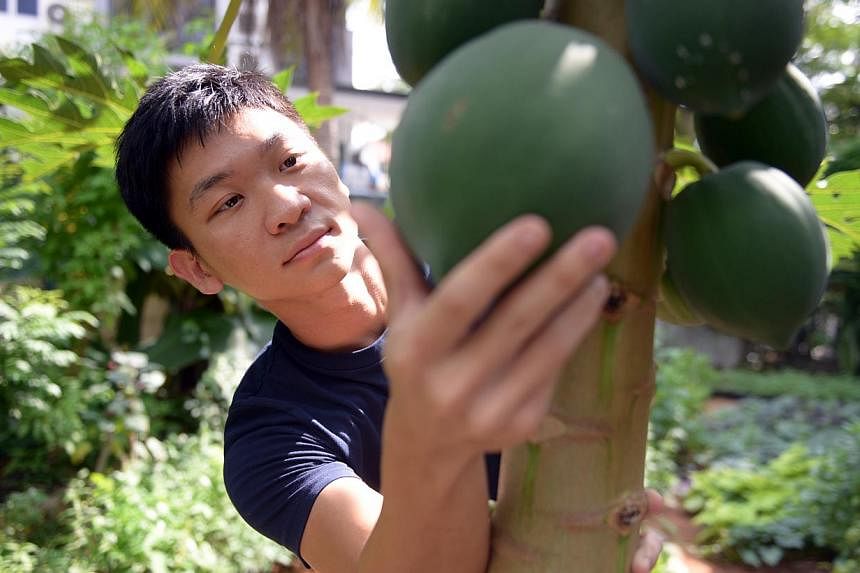As a child, Mr Alexius Yeo helped his mother tend to her pots of flowers. Later, as a streetscape manager at the National Parks Board, he helped maintain roadside greenery.
But it never occurred to him to grow edible plants until he went to the Philippines in October 2012 to volunteer with the non-governmental group Gawad Kalinga for eight months. Based in the Philippines, the group aims to reduce poverty and has built thousands of villages in the country.
The 29-year-old recalls: "I was assigned to a farm to do landscaping. There were not many ornamental plants around, so I found myself landscaping food plants such as lemongrass and sweet potatoes."
The experience made him realise the value of growing plants that are "not only good to look at, but also edible".
"When we grow something as basic as our own food and are sustained by it, we find a personal connection to the place they grow in," he says.
He sees building beautiful edible landscapes as one way Singaporeans can develop a deeper connection with their land and the people they share it with.
When he returned to Singapore in June 2013, he joined Edible Garden City as an urban farmer. The social enterprise designs, builds and maintains edible landscapes.
In June last year, he asked his parents, with whom he lives, if he could turn the lawn in their Serangoon North corner terrace house into an edible garden. The patch is about one third the size of a basketball court.
The bachelor says: "Since I was helping people create edible landscape, I thought I should also do my own."
With his parents' approval, Mr Yeo, who was then working part-time with Edible Garden City, started to prepare the soil. That was the "most physically tiring part", which took him three afternoons every week for four months. It involved digging out the grass, creating raised vegetable beds and manually mixing the compost into the beds.
Once he got that part done, he began planting the seeds and bringing in the plants. All in, he spent about $600, largely on soil and plants.
He makes his own chemical-free pesticide by crushing together neem leaf, chilli and garlic and soaking them in water. He also creates fertilisers from leftover vegetables and coffee grounds.
Today, his plot is thriving and contains 10 kinds of local vegetables and 15 types of herbs.
He says: "I wanted to grow local vegetables because they are better adapted to the climate here and are hence easier to grow. I am also excited to bring back vegetables that used to be popular among Singaporeans, such as mugwort and mani cai."
He also grows speciality herbs such as chocolate mint and cinnamon basil, which are not readily available in supermarkets.
Mr Yeo, who now runs Carbon Inq, a nature-based experiential learning programme for schools, spends less time on his garden these days, but he still harvests the plants three times a week. His parents, both retirees, and his brother, 32, a computer animator, help him occasionally.
His mum, Mrs Isabel Yeo, 67, the main cook in the family, says: "I like that I can just go out to the garden to pluck what I need for my cooking. The plants are very fresh and fragrant. I never teared when I cut spring onions in the past, but I do when I cut those I pluck from the garden."
To encourage his neighbours to start their own edible gardens, Mr Yeo opened up his garden to them last month.
About 25 people turned up, some from as far as Jurong, after learning about it through word of mouth. Mr Yeo also slipped pamphlets about the event into the mailboxes of his neighbours' houses.
Over two hours, the group had a hands-on session in the garden followed by a potluck gathering where they got to know one another.
Mr Yeo says: "It was heartening to see people of all ages and from all professions. There's definitely an interest here in growing your own food, but people often do not know where or how to start."
To provide some answers to these questions, he plans to run free workshops at his place every month. Besides giving tips to his neighbours on how to grow edibles and cook them, he will also invite them to get their hands dirty in his garden.
He says: "It's my way of connecting with my neighbours through doing something meaningful together. When you grow your own food, you will come to better appreciate how much time and effort go behind its production."
A version of this story appeared in the April 2015 issue of The Life e-magazine in The Straits Times Star E-books app, with the headline "Edible landscape".


